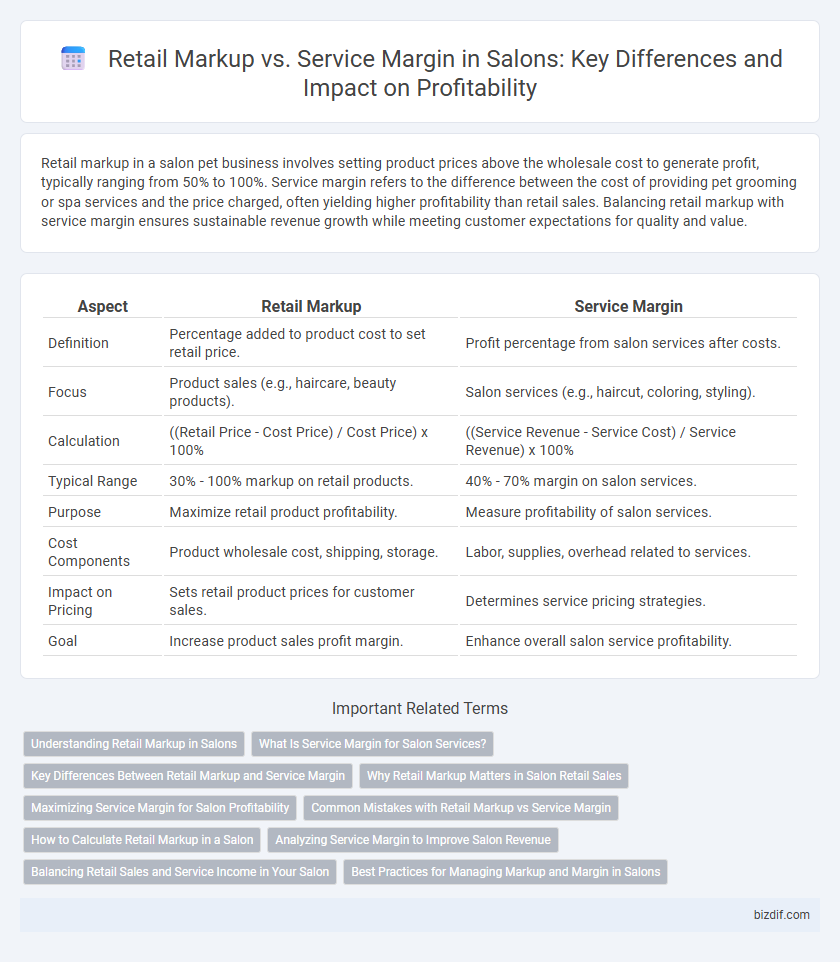Retail markup in a salon pet business involves setting product prices above the wholesale cost to generate profit, typically ranging from 50% to 100%. Service margin refers to the difference between the cost of providing pet grooming or spa services and the price charged, often yielding higher profitability than retail sales. Balancing retail markup with service margin ensures sustainable revenue growth while meeting customer expectations for quality and value.
Table of Comparison
| Aspect | Retail Markup | Service Margin |
|---|---|---|
| Definition | Percentage added to product cost to set retail price. | Profit percentage from salon services after costs. |
| Focus | Product sales (e.g., haircare, beauty products). | Salon services (e.g., haircut, coloring, styling). |
| Calculation | ((Retail Price - Cost Price) / Cost Price) x 100% | ((Service Revenue - Service Cost) / Service Revenue) x 100% |
| Typical Range | 30% - 100% markup on retail products. | 40% - 70% margin on salon services. |
| Purpose | Maximize retail product profitability. | Measure profitability of salon services. |
| Cost Components | Product wholesale cost, shipping, storage. | Labor, supplies, overhead related to services. |
| Impact on Pricing | Sets retail product prices for customer sales. | Determines service pricing strategies. |
| Goal | Increase product sales profit margin. | Enhance overall salon service profitability. |
Understanding Retail Markup in Salons
Retail markup in salons refers to the percentage increase applied to the wholesale cost of products to determine their retail price, directly impacting profitability. Understanding retail markup involves analyzing product cost, competitor pricing, and customer demand to set prices that maximize revenue without deterring purchases. Effective markup strategies ensure salons cover overhead costs while offering competitive prices on retail items like shampoos, conditioners, and styling tools.
What Is Service Margin for Salon Services?
Service margin for salon services represents the percentage of profit retained after covering the direct costs of delivering a service, such as labor, materials, and overhead expenses. It differs from retail markup, which applies to products sold and is based on the difference between the product's cost and selling price. Calculating service margin helps salon owners set competitive pricing while ensuring profitability on haircuts, coloring, styling, and other treatments.
Key Differences Between Retail Markup and Service Margin
Retail markup represents the percentage added to the cost price of products sold in a salon, directly impacting the retail profit. Service margin, on the other hand, is the difference between the revenue generated from salon services and the associated operational costs, reflecting overall service profitability. Key differences lie in retail markup focusing on product pricing strategies, while service margin emphasizes efficient service delivery and cost control.
Why Retail Markup Matters in Salon Retail Sales
Retail markup in salon retail sales drives profitability by setting product prices above wholesale costs, ensuring a healthy revenue stream beyond service income. Unlike service margin, which is tied to labor and operational efficiency, retail markup directly impacts inventory turnover and client perception of value. Prioritizing effective retail markup strategies helps salons maximize profit potential and sustain business growth through product sales.
Maximizing Service Margin for Salon Profitability
Maximizing service margin in salons involves focusing on high-quality, high-value treatments that yield greater profit compared to retail product sales, which often have lower markups and slower inventory turnover. Prioritizing skilled service delivery, personalized client experiences, and premium pricing strategies significantly enhances overall profitability. Efficiently managing appointment schedules and upselling customized services further optimizes service margins, driving sustainable growth in salon revenue.
Common Mistakes with Retail Markup vs Service Margin
Common mistakes with retail markup versus service margin in salons include confusing markup percentage with profit margin, leading to incorrect pricing strategies that reduce overall profitability. Salons often apply a flat retail markup without considering the labor and overhead costs embedded in service margins, resulting in underpriced services or overstocked retail products. Accurately distinguishing between retail markup, which focuses on product resale price, and service margin, which accounts for total service costs and profitability, is essential for sustainable revenue growth.
How to Calculate Retail Markup in a Salon
To calculate retail markup in a salon, subtract the wholesale cost of a product from its retail price, then divide the result by the wholesale cost and multiply by 100 to get a percentage. For example, if a shampoo costs $10 wholesale and sells for $20, the retail markup is ((20 - 10) / 10) x 100 = 100%. Understanding retail markup helps salon owners price products competitively while maintaining profitability.
Analyzing Service Margin to Improve Salon Revenue
Analyzing service margin in salons reveals key opportunities for revenue growth by identifying high-margin services and optimizing pricing strategies based on labor and product costs. Insufficient service margins often indicate underpriced treatments or inefficient resource allocation, directly impacting overall profitability. Implementing targeted adjustments in service offerings and cost controls enhances salon revenue without relying solely on retail markup.
Balancing Retail Sales and Service Income in Your Salon
Balancing retail markup and service margin is crucial for maximizing overall salon profitability by optimizing both product sales and service revenue. Retail markup typically ranges from 50% to 70%, providing higher immediate profit per item, while service margins average around 70% to 80% due to labor and overhead costs. Strategic pricing and staff training on product recommendations can enhance retail sales without compromising high-margin services, driving sustainable income growth for salons.
Best Practices for Managing Markup and Margin in Salons
Effective retail markup in salons typically ranges from 50% to 100%, ensuring product profitability without deterring clients. Service margin should be optimized by analyzing labor costs, product usage, and overhead, commonly targeting a 60%-70% margin to sustain business growth. Implementing dynamic pricing strategies and regularly reviewing cost structures allows salons to balance competitive pricing with healthy profit margins.
Retail Markup vs Service Margin Infographic

 bizdif.com
bizdif.com